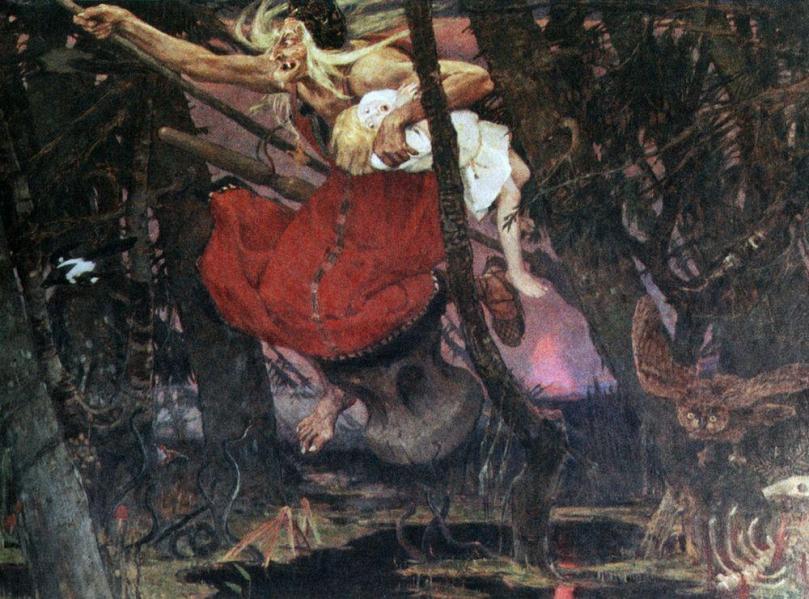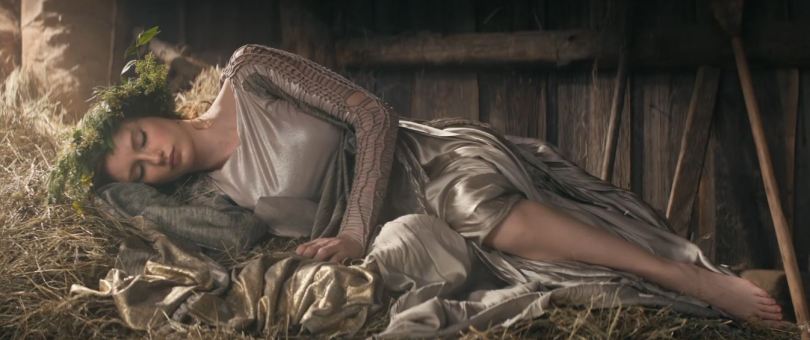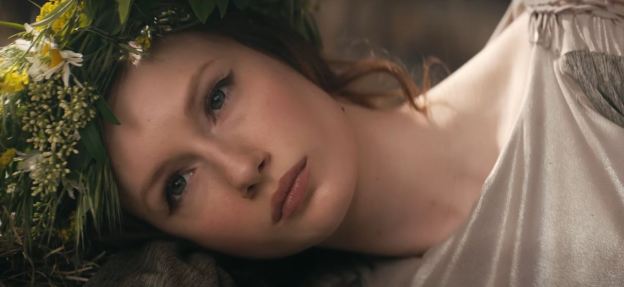About a year ago Allegro embarked on making a series covering Polish Legends/Polish Stories. They’ve covered a few so far, but the most recent one, is their take on the story of Baba Jaga.
It’s a video I strongly suggest watching, but before you watch it, I think you may need to know a little bit about Baba Jaga to undertsand why I find their take on the story a great one.
So what or who is Baba Jaga?
Baba Jaga is a woman, a witch.
 Wikimedia – Commons
Wikimedia – Commons
Baba Jaga is not just your typical crone, according to the legends, she sports iron teeth, bony legs and often some other additional grotesque feature such as a huge nose, or huge breasts (hmm), she is also often blind or visually impaired. She has some enviable real estate; a house that is supported up by a chicken leg (or legs), a fence topped with skulls in which the eyes glow. If this was not enough, she has a top of the range witch broom and mostly travels in a pestle and mortar (talk about grinding gears). Baba Jaga is said to kidnap children and devour them, and she is sometimes an ambiguous figure, who might either harm or help (take the story of Vasilisa). In most of the stories I have read she doesn’t seem to like good in general. Like most witches who come from the forest, she has good knowledge of the plants and herbs around her, which she manipulates with great effects.
It also seems that the legend of Baba Jaga is spread (like most things) across most Slavic nations and has influenced similar stories in other cultures.
Allegro weaves a pretty nice story between all the short films they have released, and here is what I was drawn to/noted about the Baba Jaga story.
Legendy polskie – „Jaga”
First their depiction of Baba Jaga. She was not an old hideous crone, but rather a maiden; with flowing red hair, a green wreath upon her head, fiery green eyes to match and a dress that looked ethereal, something you’d expect a woodland elf to wear. She looks nothing like the crone we are told about in the stories.
As a character she has an unnerving calm while fighting (against humans). She clearly has a very deep connection to nature; the forest. She has a strong desire to return to her grove and her desire to return is fueled by the irreverence of nature & the hope that people still wonder about the old days (Slavic Paganism is strongly tied to the primeval forests). After getting injured in the EPIC fight scene, she takes some herbs growing on the bark of the barn and heals her wounds, which shows us to the ‘healer’ aspect of Baba Jaga. I do think Baba Jaga in the stories has the same connection to nature that the one depicted in Allegro’s film had. As for the awesome fight scene, I am not so sure that the Baba Jaga I read about could even fight (or would need to), but I really enjoyed Allegro’s depiction of her fighting in this manner.
I did not get much of her ambiguity in the short film, as she seemed more a good ‘being’ (caring about nature, about the lost ‘old ways’). Perhaps the face of Baba Jaga was ambigious (?), I think the actress did a good job in keeping her face relatively emotionless, or showed subtle hints of emotion, but there was always a fire conveyed through the eyes. The only thing which alluded to her being a source of bad/evil (or maybe unchristian), was the Boruta (devils) reference to keeping her locked up under what seemed the command of the angels. He says, ‘what will heaven say when they know that Slavic Demons are running loose’. Indeed Boruta, indeed.
After watching the Baba Jaga short story released by Allegro , I wondered; why are witches mostly old and purposefully grotesque looking women?
I thought back about the movies with witches I did remember: Disney’s Snow White, Hocus Pocus, The Wizard of Oz, The Witches, and general stories about witches who always seemed to follow the same formula.
Now I don’t have a firm answer backed up by research, but I wondered if it was because older women (back then) held vast knowledge when it came to cures, herbal medicines, stories and advice. In my own culture I know that the grannies have all the best cures for a sickness and all the lessons from the past! Well that might explain the old part.
What about the ugly part? Well perhaps this was for the scare factor? Scaring kids with abnormal features. Scaring them into behaving? Maybe it was because back then aging was very different from what it is now. 50 is the new 40 which is the new 30 which is as good as 20 say all the magazines…
Then I wondered about Baba Jaga specifically (as we don’t have many witches in my culture to start with). I thought about the Allegro version, I know that they must have done extensive research and must have chosen a reason for their interpretation of Baba Jaga. Tomasz Bagiński is a part of the Allegro project and he is a genius, so I don’t think it is solely some artistic fancy to show this version of Baba Jaga. I wondered if Baba Jaga was at one time a good witch, a protector of people and the forest, then with Christianity replacing Slavic Paganism, certain aspects had to be changed or demonised? It has happened before, where Christianity either absorbed pagan festivals/stories/holidays or made the current gods gruesome. There are examples around the world where other legends and gods were changed to make them more unattractive, scary and unpleasant.
I tried to research this a bit, however when English sources are thin, it isn’t an easy or rewarding task.
What I did manage to find was a conclusion drawn from the book (“Od matriarchatu do patriarchatu”) written by Zygmunt Krzak (an archeologist), which mentions that Baba Jaga could have been a goddess which was made hideous to suite the new patriarchal order. It also says that the thread of Baba Jaga kidnapping children and eating them could refer to a the ritual initiation of young children. There is a group of researchers who believe that they can piece together the original Baba Jaga, the form before it was made grotesque, and that the original form was a Mother Goddess type.
Maybe they already have and I just haven’t read it in English, but I hope that they can trace the proper roots of Baba Jaga. If it really is the goddess/priestess/witch that was more beauty than blight, I think that Allegro did a very good job in showing a different side to this old legend, and is a good start of setting a story right.
Enjoy the movie and let me know your thoughts or anything you might know on Baba Jaga!
Tamka

